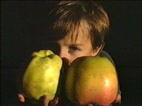 |
HOME lescrets fruits et pomologie Site personnel d'information à caractère non commercial et gratuit - Free personal site of information to non commercial character |
|||||
GREFFER LES ARBRES FRUITIERS
Grafting fruit trees
Time to graft Relation stock/scion Grafting wax
shield budding Whip-Grafting Cleft Grafting
A good grafting wax is made from the following formula: 4 pounds resin, 2 pounds beeswax, 1 pound beef tallow.
Pulverize the resin and cut up the beeswax and tallow. Boil together slowly until all are entirely dissolved. Pour this into a pail of cold water, and after greasing the hands, squeeze all the water out of the wax and pull, as one would molasses candy, until the wax becomes light colored. If wrapped in oilpaper, this may be stored until needed. In cold weather, when the wax is hard to work, it should be slightly heated before using.
For cleft-grafts pull the wax out into wide ribbons, and cover first the sides of the cleft, then the entire upper surface of the stub, being especially careful to press the wax firmly around the scion to prevent the stock and scions from drying out. The tips of the scion may also be covered with wax.
Waxed string can be made by dropping a ball of darning cotton into the boiling wax and allowing it to cool or harden. The raffia used in tying grafts may be purchased from seed stores or nurserymen; it consists of ribbonlike strips of fiber from the palm tree.